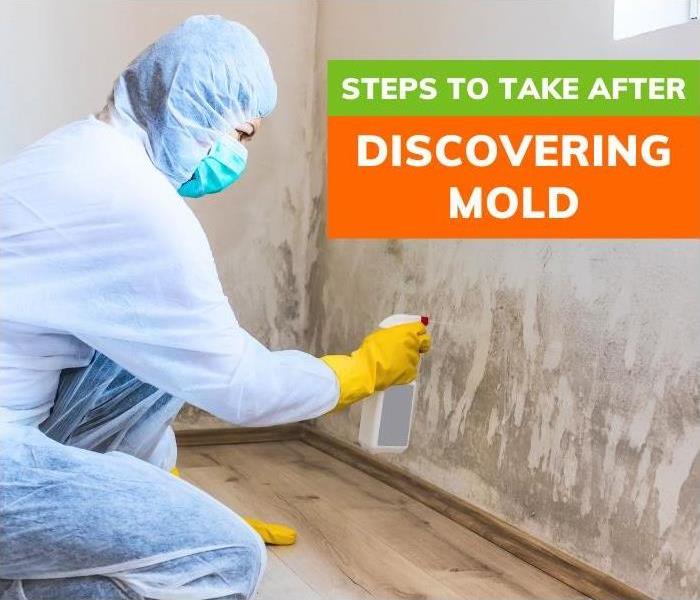Steps to Take After Discovering Mold
1/29/2025 (Permalink)
Steps to Take After Discovering Mold
Mold infestations can negatively impact the safety and comfort of homes, rental units, commercial buildings, and more. From damp basements to hidden plumbing leaks, mold thrives in damp, poorly ventilated environments. Effectively managing and preventing mold outbreaks requires understanding their causes and the remediation process. Identifying, addressing, and preventing mold growth pays dividends in improving homes, rental units, and commercial spaces.
Track Moisture Sources
Mold grows and thrives in humid or damp environments, and it is essential to identify the moisture sources causing the problem. Monitor water usage and have pipes checked for leaks. Inspect interior ceilings and walls, and look around windows for signs of leaks or moisture. Externally, check for damaged roofing, such as missing or broken shingles.
Inspect bathrooms, basements, and other areas prone to condensation in the building or home. Monitor humidity levels inside using a hygrometer or other type of moisture sensor. Address and fix any moisture or plumbing issues immediately.
Assess the Problem
The severity of mold growth will dictate how to handle the problem and whether calling in professional help is necessary. Use a tape measure or appropriate app to measure the size of the area affected by mold. Examine ceilings, walls, and floors to look for signs of spreading. Additionally, notice if a moldy smell is present, even if you do not see visual signs of infestation.
Check underneath and behind furniture, under carpets, and other hidden spaces. Mold can hide in unsuspected areas, such as on the back of the wallpaper, wood paneling,g or ceiling tiles. Take photos or videos of the findings for future reference to see whether the problem is worsening or if the mold returns once the situation is resolved.
Isolate the Mold
Mold spores are visually undetectable and can travel and spread to new areas. Steps to take after discovering mold include keeping spores contained for effective management and removal. Seal off areas that contain mold by using plastic sheeting or drop cloths and duct tape to secure them. Close off HVAC vents in the affected area, especially since mold spores can travel through HVAC vents and into other areas of the home or building.
Air purifiers that use HEPA filters can capture airborne mold spores, making them an essential addition to the HVAC system. Alert family members or tenants about the contaminated space and ask them to avoid entering or disturbing it.
Wear Safety Gear
Invisible mold spores can cause respiratory issues and other problems, so put safety first by wearing protective gear when handling mold removal.
Use a respirator or an N95 mask to protect from inhaling mold spores that become airborne during removal.
Additionally, avoid touching mold with bare hands and wear long-sleeved clothing, goggles, and gloves. Remember to discard contaminated protective gear, such as masks, after use.
Mold and Rental Properties
Mold problems can go unnoticed and escalate in rental properties, especially when experiencing high tenant turnover. Have the property inspected thoroughly as soon as existing tenants move out. Educate new tenants about mold issues and the importance of promptly reporting water leaks and mold sightings.
Keep maintenance records to identify units with recurrent mold issues. For problem areas, implement proactive measures such as dehumidifiers in units prone to mold development.
Removing Visible Mold
Removing all visible mold from building surfaces is essential for restoring a healthy, clean living environment and is one of the crucial steps to take after discovering mold. Use detergent or a solution of vinegar and water, or for more challenging problems, use a commercial product formulated for mold removal.
Non-porous surfaces such as metal and tile can be scrubbed with a brush. If porous materials, such as carpet or drywall, are beyond salvaging, they must be discarded. Wherever mold has been present, the areas require thorough cleaning to prevent regrowth.
Dry Affected Areas
Eliminating moisture and humidity ensures mold does not regrow after the remediation process. Dry surfaces externally using dehumidifiers and fans. If the weather permits, open windows for fresh air and ventilation.
Using a moisture meter, check for any residual moisture in the affected area. Give cleaned and repaired spaces adequate time to dry completely before painting or sealing. If mold or dampness remains, the paint or sealant will eventually peel.
Ensure a Thorough Cleanup
Flooded areas of a home, rental unit, or commercial building may appear fine after the initial dry-out period. However, failing to remove all contaminated materials can increase health risks and reduce air quality. In addition to mold, wet materials and standing water are breeding grounds for bacteria and other microorganisms, such as viruses.
These pathogens can trigger allergic reactions, cause diseases, and contribute to damage that continues long after the initial flood cleanup.
If contaminated water or sewage causes mold or water damage, consider hiring a professional service to handle the cleaning and repairs.
Mold in the HVAC System
Mold spores can travel and spread through air ducts, making an HVAC system a potential source of problems. Inspect the HVAC system's filters, coils, and vents for dust build-up or signs of mold. Replace the HVAC system's filters regularly to ensure improved air quality.
Consider professional duct cleaning if the HVAC system is especially dusty or heavily contaminated. Condensation can also build up in ducts, so ensure proper cleaning and maintenance to prevent the conditions that trigger mold growth.
Monitor for Signs of Recurrence
Maintaining ongoing vigilance, especially in known problem areas, is essential to avoid a repeat mold infestation. Steps to take after discovering mold include scheduling periodic inspections of any areas that have had mold issues. Look for any discoloration, pay attention to areas that smell moldy, and look for visible signs of mold regrowth.
Install moisture or humidity sensors to provide an alert if high moisture levels occur. Act promptly at the first signs of mold or moisture to get the area dried out and clear of mold.
Catch Water Damage and Mold Promptly
Mold can cause property damage and illnesses that can become extremely costly to resolve. Addressing mold requires vigilant inspections, thorough cleanup, and effective prevention measures.
Identifying moisture sources and isolating mold are the first essential steps in remediation. Ensuring the affected areas are properly dried and treated is the best insurance to prevent the problem from reoccurring. Whether tackling a minor mold-growth issue or handling extensive damage, remember that water intrusions come in many forms and are the most common root of mold problems.
Swift action to identify and resolve the issues protects properties and makes them safer for all parties. When you need the expertise of professional mold remediation, SERVPRO® has the experience and equipment to handle the job. Contact us today to find out more.






 24/7 Emergency Service
24/7 Emergency Service
